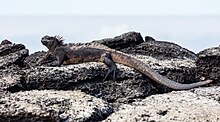Marine Iguana
| Marine iguana | |
|---|---|
 |
|
| Scientific classification | |
| Kingdom: | Animalia |
| Phylum: | Chordata |
| Class: | Reptilia |
| Order: | Squamata |
| Suborder: | Iguania |
| Family: | Iguanidae |
| Genus: |
Amblyrhynchus Bell, 1825 |
| Species: | A. cristatus |
| Binomial name | |
|
Amblyrhynchus cristatus (Bell, 1825) |
|
| Subspecies | |
|
7 ssp.; see text |
|
 |
|
7 ssp.; see text
The marine iguana (Amblyrhynchus cristatus) is an iguana found only on the Galápagos Islands that has the ability, unique among modern lizards, to forage in the sea, making it a marine reptile. The iguana can dive over 9 m (30 ft) into the water. It has spread to all the islands in the archipelago, and is sometimes called the Galápagos marine iguana. It mainly lives on the rocky Galápagos shore to warm from the comparatively cold water, but can also be spotted in marshes and mangrove beaches.
Listed alphabetically.
A. c. albemarlensis
A. c. cristatus
A. c. hassi
A. c. mertensi
A. c. nanus
A. c. venustissimus
On his visit to the islands, despite making extensive observations on the creatures, Charles Darwin was revolted by the animals' appearance, writing:
Marine iguanas are medium-sized lizards (200–340 mm (7.9–13.4 in), adult snout–vent length) and are unique as they are marine reptiles due to their foraging on inter- and subtidal algae only. These iguanas forage exclusively in the cold sea, which leads them to behavioral adaptations for thermoregulation.
Amblyrhynchus cristatus is not always black; the young have a lighter coloured dorsal stripe, and some adult specimens are grey, and adult males vary in colour with the season. Dark tones allow the lizards to rapidly absorb heat to minimize the period of lethargy after emerging from the water. The marine iguana lacks agility on land but is a graceful swimmer. Its laterally flattened tail and spiky dorsal fin aid in propulsion, while its long, sharp claws allow it to hold onto rocks in strong currents.
Marine iguanas vary in body size, which is different depending on the island the individual iguana inhabits. The iguanas living on the islands of Fernandina and Isabela (named for the famous rulers of Spain) are the largest found anywhere in the Galápagos. On the other end of the spectrum, the smallest iguanas are found on the island on Genovesa.
Adult males weigh from a maximum of 12–13 kg (26–29 lb) on southern Isabela to about 1–2 kg (2.2–4.4 lb) on Genovesa. The reason for this difference in body size of marine iguanas between islands is due to "variability in algal productivity and sea surface temperature."
...
Wikipedia

